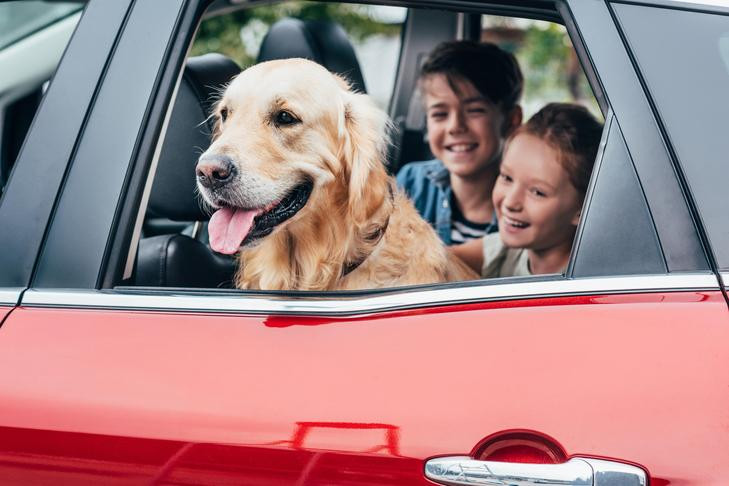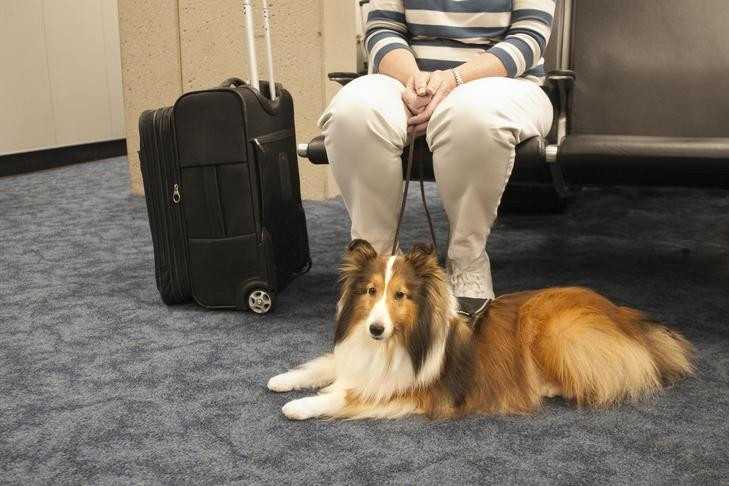Taking your dog on vacation can enrich the experience for everyone involved, turning a simple getaway into a memorable family adventure. However, successful pet travel requires careful planning and consideration. This guide provides essential tips to ensure your journey with your canine companion is both enjoyable and safe.
Prioritizing Your Dog’s Health and Safety During Travel
Before embarking on any extended trip, a veterinarian check-up is paramount. Ensure your dog’s vaccinations are current, and obtain their shot records, particularly if air travel is involved, as health certifications may be required. Consult your vet to confirm your dog is physically and mentally fit for travel, as not all dogs are suited for the stresses of travel.
Maintaining your dog’s health on the road involves several key steps. Pack an adequate supply of their regular dog food to avoid digestive upset from dietary changes. Always carry bottled water to prevent illness from unfamiliar water sources. Crucially, remember to bring any necessary medications your dog requires.
Be prepared for potential emergencies. Before you leave, locate the nearest 24-hour veterinary emergency hospital at your destination and save their number in your phone. Also, keep your regular veterinarian’s contact information readily accessible, including both office and emergency numbers, for seamless communication should a medical situation arise.
 Golden Retriever happily sitting in the backseat of a car with children, illustrating safe and enjoyable family travel with a dog.
Golden Retriever happily sitting in the backseat of a car with children, illustrating safe and enjoyable family travel with a dog.
The Importance of Dog Travel Crates for Safe Journeys
A dog crate is not just a travel accessory; it’s a safety essential, especially when traveling by car or airplane. A crate provides a secure space for your dog in the car, minimizing distractions for the driver and protecting your pet in case of sudden stops. For air travel, crates are mandatory and must meet specific airline regulations. Beyond transportation, a crate serves as a familiar and safe haven for your dog in unfamiliar environments like hotels or friends’ homes, preventing potential mishaps. Equip the crate with comfortable bedding, such as an orthopedic dog crate pad, a favorite toy for comfort, and a dog water bottle for hydration during travel.
When selecting a dog travel crate, consider these vital features:
- Size Appropriateness: The crate should be large enough for your dog to comfortably stand, turn around, and lie down.
- Durability and Safety: Opt for a strong crate with secure handles and grips, free from any internal protrusions that could harm your dog.
- Leak-proof Base: Ensure the crate has a leak-proof bottom lined with absorbent material for easy cleanup and hygiene.
- Ventilation: Adequate ventilation on opposing sides is crucial for airflow, with exterior rims or knobs to prevent blockage.
- Clear Labeling: The crate should be labeled “Live Animal” with arrows indicating the upright position, and include your name, address, and phone number for identification.
Ensuring Dog Identification for Travel Safety and Peace of Mind
Dog identification is critically important when traveling. In the unfortunate event that your dog becomes lost, proper ID significantly increases the chances of a swift reunion.
- Collar and Leash with ID Tags: Always use a sturdy dog leash and collar. The collar must have identification tags clearly displaying your dog’s name, your name, and your permanent phone number. Include proof of rabies vaccination on the tag. For extended trips, consider adding a temporary tag with your vacation location’s address and phone number.
- Microchipping for Permanent Identification: Microchipping provides a permanent and reliable form of identification that is essential for travel safety.
- Up-to-date Photo and Records: Carry a recent photograph of your dog and copies of their health and vaccination records. These are invaluable if your dog gets lost and for any unexpected veterinary visits.
 Sealyham Terrier resting comfortably in a secure travel crate, highlighting the safety and comfort crates provide for dogs during travel.
Sealyham Terrier resting comfortably in a secure travel crate, highlighting the safety and comfort crates provide for dogs during travel.
Car Travel with Dogs: Making the Ride Safe and Comfortable
Acclimate your dog to car travel gradually. Start with short trips, progressively increasing the duration. Utilize dog seatbelts, car seats, or safety harnesses to secure your dog during car rides, ensuring their safety and minimizing distractions while driving.
Maintain good ventilation in the car to keep your dog comfortable, especially if they are crated, ensuring fresh air circulation. To prevent car sickness, avoid feeding your dog immediately before travel. However, always ensure they have access to fresh water. Plan frequent stops for exercise, bathroom breaks, and responsible waste disposal.
Never allow your dog to ride unrestrained in the back of an open truck bed – this is extremely dangerous. Equally critical, never leave your dog unattended in a parked car, especially during warm weather, as temperatures inside a closed vehicle can rise rapidly and become fatal. If you must leave the car, have a designated person stay with your dog.
Air Travel with Dogs: Navigating Airline Regulations
When planning air travel with your dog, make reservations for your pet at the same time as booking your own flight. Airlines have limitations on the number of animals allowed per flight, and spaces are allocated on a first-come, first-served basis.
Prior to flying, schedule a veterinary visit. Be aware that each airline has specific rules and regulations for animal travel. While a health certificate might not be required for all domestic flights, specific state regulations may apply. Your veterinarian can confirm your dog’s fitness to fly and ensure all necessary vaccinations are up-to-date.
Airlines emphasize that pet owners are responsible for confirming their dog’s health and suitability for air travel. Discuss with your vet whether sedation is advisable for your dog during the flight. Critically, check the weather conditions at both your departure and arrival points, as extreme temperatures may make air travel unsafe for your dog.
 Shetland Sheepdog service dog calmly lying next to its owner at the airport, demonstrating responsible and comfortable air travel with a well-trained dog.
Shetland Sheepdog service dog calmly lying next to its owner at the airport, demonstrating responsible and comfortable air travel with a well-trained dog.
Exploring Other Travel Options: Trains, Buses, and Boats with Dogs
Amtrak’s pet policy currently permits small dogs (under 20 pounds) on certain trains. However, major bus lines like Greyhound generally do not allow pets, although service animals are an exception. Local bus and rail services will have their own pet policies, so check in advance.
Cruise lines vary significantly in their pet policies. If you are considering a cruise with your dog, thoroughly investigate the specific cruise line’s pet regulations before making any bookings.
For international travel with your pet, extensive preparation is necessary. Research and understand the regulations for traveling internationally with pets to ensure a smooth journey.
Essential Tips for Smooth Dog Travel Experiences
Regardless of your mode of transport, planning for bathroom breaks is essential. Train your dog to eliminate on various surfaces beyond just grass before your trip. This adaptability will prevent discomfort and accidents during travel. Always carry poop bags for cleanup and keep your dog leashed in public areas.
To prevent boredom and anxiety, pack a mix of familiar and new toys for your dog, including puzzle toys to keep them mentally engaged. Remember food and water, and consider using bottled water throughout your trip to avoid stomach upsets. Collapsible travel bowls are space-saving and convenient for on-the-go feeding and hydration. Introduce these bowls to your dog before your trip to ensure they are comfortable using them.
Finding Dog-Friendly Hotels and Accommodation
Before you travel, research and identify dog-friendly hotels or motels along your route and at your destination. Many establishments have restrictions on pets, including size limits. When staying at a dog-friendly hotel, be considerate of other guests, staff, and the property. Keep your dog quiet, always leashed in public areas of the hotel, and never leave them unattended in your room.
Upon arrival, inquire about designated dog-walking areas and always clean up after your dog. Responsible pet etiquette ensures that hotels continue to welcome dogs. Treat your hotel room with respect and leave it in good condition.
Always puppy-proof your accommodation, regardless of the type. Before allowing your dog to explore, check for potential hazards like exposed electrical cords or small objects left behind by previous guests that could be harmful.
Remember, it’s a vacation for both of you. Travel can be stressful, but your dog will mirror your emotions. A calm and relaxed owner usually means a calm and relaxed pet. If you are anxious, your dog will likely sense and reflect that stress. Recognize that travel isn’t for every dog. If your dog is particularly anxious or doesn’t enjoy travel, consider the option of leaving them in the care of a trusted dog sitter in the comfort of their own home.

